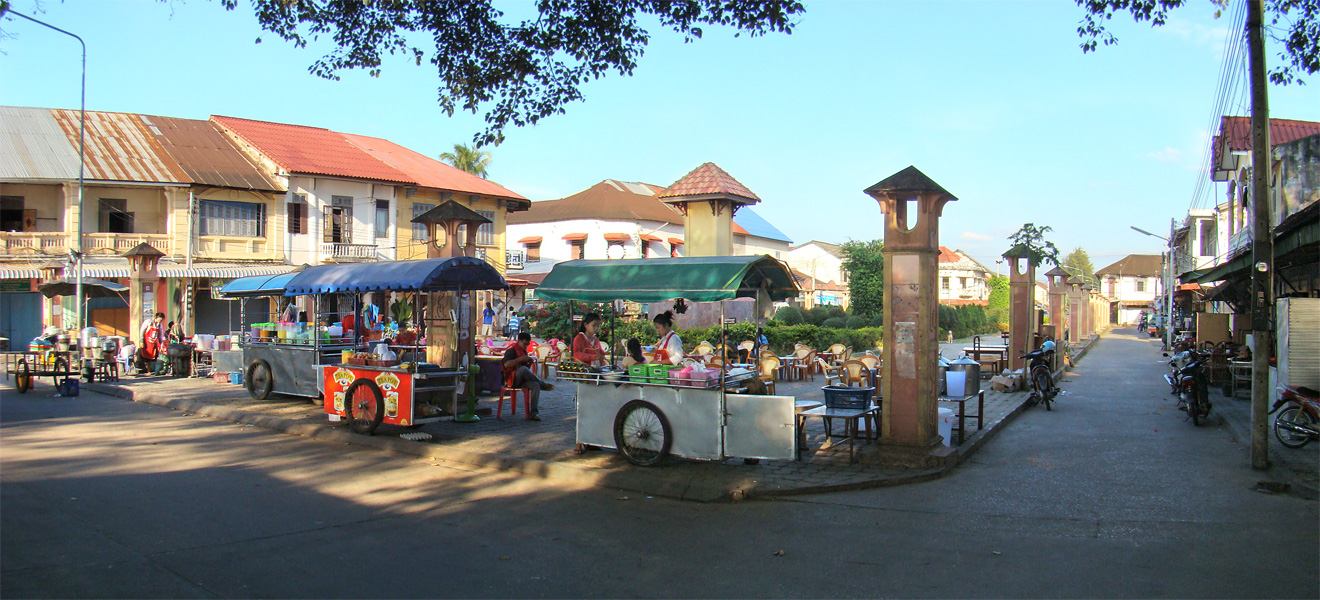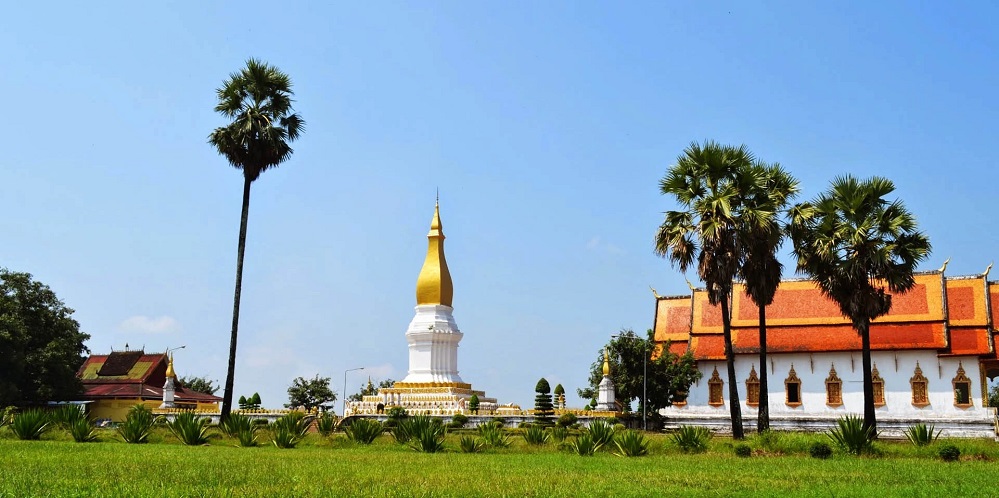Thakhek

Thakhek
Thakhek s a town in south-central Laos on the Mekong River and facing Nakhon Phanom across the river in northeastern Thailand. It is the capital of Khammouane Province. The city has many French colonial style official buildings, villas and shops. The population is 85,000 people. Thakhek is the pretty town in the south-central of Laos on the Mekong River and is the capital of Khammouane Province
Khoun Kong LengKhoun Kong Leng is a lake located in Khammouane province, Laos. The lake is approximately 35 metres deep and is amazingly beautiful with bright green waters. The water flows underground passing through limestone, giving the water a green colour. Locals believe that the lake has magical powers and that it can ring a gong at night during a full moon. The lake’s name, Kong Leng, means evening gong.
Khoun Kong Leng is open to the public 7 days per week for swimming, rope swinging and simply relaxing. Food and drink is available for purchase from our kiosk. Entry fee is approximately 5,000 Kip per person. Khoun Kong Leng is around 30 kilometres north east of Thakhek. Go north on Route 13, turn right heading east at Km-29 on to a dirt road. After around 2 kilometres turn right heading south again. Go over the hills and past villages for 16 kilometres until you reach Ban Na Kheu. It is 1 kilometre from this village to the lake.
 Nang Aen is a massive cave 15km east of Thakhek and 1km south off Route 12 along Cave Alley. The spectacular cave, 30 metres high in the central chamber, is named after the legendary orphan Nang Samounta.
Nang Aen is a massive cave 15km east of Thakhek and 1km south off Route 12 along Cave Alley. The spectacular cave, 30 metres high in the central chamber, is named after the legendary orphan Nang Samounta. The legend of this cave is linked to Tham Xienglieb Cave. The story goes, that Xieng, the young former novice who went looking for the beautiful daughter of the hermit at Tham Xienglieb Cave, met with her at the entrance of this cave. Here the two lovers sat (meaning nang in Lao) and flirted (aen kan). Hence the name Tham Nang Aen (Cave of Sitting and Flirting). This cave is a favorite weekend destination for Lao and Thai people and is a great place to cool off from the heat because of the constant cool breeze blowing out of cave’s natural air conditioning. The cave is up to 30 meters-high in some places and over 1,5 kilometers-long. It contains a small underground lake and impressive limestone formations. The cave is well lit and cement walkways and steps have been constructed for visitor safety. The large cave entrance is accessed through a wooden ceremonial structure built in 1987 for the visit of the Princess of Thailand. On the grounds just outside the cave is a simple zoo with several animals and a very large Mai Kaphoung tree.
The legend of this cave is linked to Tham Xienglieb Cave. The story goes, that Xieng, the young former novice who went looking for the beautiful daughter of the hermit at Tham Xienglieb Cave, met with her at the entrance of this cave. Here the two lovers sat (meaning nang in Lao) and flirted (aen kan). Hence the name Tham Nang Aen (Cave of Sitting and Flirting). This cave is a favorite weekend destination for Lao and Thai people and is a great place to cool off from the heat because of the constant cool breeze blowing out of cave’s natural air conditioning. The cave is up to 30 meters-high in some places and over 1,5 kilometers-long. It contains a small underground lake and impressive limestone formations. The cave is well lit and cement walkways and steps have been constructed for visitor safety. The large cave entrance is accessed through a wooden ceremonial structure built in 1987 for the visit of the Princess of Thailand. On the grounds just outside the cave is a simple zoo with several animals and a very large Mai Kaphoung tree.That Sikhottabong The great Sikhottabong stupa, 29 metres high, is said to have been built on the site of an ancient Khmer stupa dating from the 9th or 10th century by King Nanthasen. It was renovated in the 15th century during the reign of King Setthathirath. Revered by a crowd of faithful Buddhists, it is one of the most important stupa of Laos. The temple hall houses a beautiful sitting Buddha. A big festival takes place there at the time of the full moon in February.
The great Sikhottabong stupa, 29 metres high, is said to have been built on the site of an ancient Khmer stupa dating from the 9th or 10th century by King Nanthasen. It was renovated in the 15th century during the reign of King Setthathirath. Revered by a crowd of faithful Buddhists, it is one of the most important stupa of Laos. The temple hall houses a beautiful sitting Buddha. A big festival takes place there at the time of the full moon in February. Tham Xieng Liab Venture into Tham Xieng Liab, where the sun peeks through holes in the cave’s roof, providing natural light on your 200-metre expedition through a mountain. Hidden behind a rock landslide under a 300-metre-high cliff, Xieng Liab Cave’s entrance launches a 400-metre hike or boat ride up the Houei Xieng Liab Creek. You can continue into the oversized opening by boat during the Green Season (May-October) or by foot in the dry season (November-April), though the walk over jagged boulders requires careful balance and your feet will get wet.
Tham Xieng Liab Venture into Tham Xieng Liab, where the sun peeks through holes in the cave’s roof, providing natural light on your 200-metre expedition through a mountain. Hidden behind a rock landslide under a 300-metre-high cliff, Xieng Liab Cave’s entrance launches a 400-metre hike or boat ride up the Houei Xieng Liab Creek. You can continue into the oversized opening by boat during the Green Season (May-October) or by foot in the dry season (November-April), though the walk over jagged boulders requires careful balance and your feet will get wet.  Locals named the cave after a former novice monk (Xieng), who was “sneaking around” (Liab) in the cavern to catch a glimpse of a mountain hermit’s daughter, with whom he was in love. Legend aside, you’ll wander past bizarre limestone formations dangling from the ceiling, and some locals say you may stumble into prehistoric wall paintings. Paa faa (soft-shelled turtles) and bats inhabit the cave, while the rare Francois langur and recently discovered kha nyou (Laotian rock rat) have found a habitat in cliffs around the cave. The stream and trail exit to a pleasant swimming hole and view of the valley beyond.To reach Tham Xieng Liab, continue along Cave Alley on Route 12 to Km 12 and Ban Songkhone Village. Cross the bridge over the Houei Xieng Liab Creek and stop at the parking area with kiosks selling refreshments. From here, take a boat up the creek or walk along a 400-metre trail to the cave.
Locals named the cave after a former novice monk (Xieng), who was “sneaking around” (Liab) in the cavern to catch a glimpse of a mountain hermit’s daughter, with whom he was in love. Legend aside, you’ll wander past bizarre limestone formations dangling from the ceiling, and some locals say you may stumble into prehistoric wall paintings. Paa faa (soft-shelled turtles) and bats inhabit the cave, while the rare Francois langur and recently discovered kha nyou (Laotian rock rat) have found a habitat in cliffs around the cave. The stream and trail exit to a pleasant swimming hole and view of the valley beyond.To reach Tham Xieng Liab, continue along Cave Alley on Route 12 to Km 12 and Ban Songkhone Village. Cross the bridge over the Houei Xieng Liab Creek and stop at the parking area with kiosks selling refreshments. From here, take a boat up the creek or walk along a 400-metre trail to the cave.
